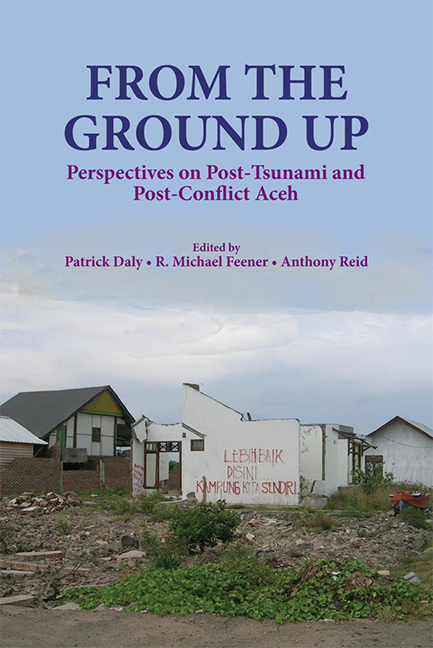Book contents
- Frontmatter
- Contents
- Preface
- List of Figures and Tables
- The Contributors
- Glossary and Abbreviations
- Introduction: Unpacking the Challenges of Post-2004 Aceh
- 1 The Sunda Megathrust: Past, Present and Future
- Part I Reconstruction Efforts
- 2 Disaster Recovery: An International Humanitarian Challenge?
- 3 Linking Relief, Rehabilitation and Development (LRRD) to Social Protection: Lessons from the Early Tsunami Response in Aceh
- 4 Cultural Heritage and Community Recovery in Post-Tsunami Aceh
- 5 Managing Post-Disaster Reconstruction Finance: International Experience in Public Finance Management
- 6 Between Custom and Law: Protecting the Property Rights of Women after the Tsunami in Aceh
- 7 Factors Determining the Movements of Internally Displaced Persons (IDPs) in Aceh
- 8 Aceh's Forests as an Asset for Reconstruction?
- Part II Conflict Resolution
- Index
7 - Factors Determining the Movements of Internally Displaced Persons (IDPs) in Aceh
from Part I - Reconstruction Efforts
Published online by Cambridge University Press: 21 October 2015
- Frontmatter
- Contents
- Preface
- List of Figures and Tables
- The Contributors
- Glossary and Abbreviations
- Introduction: Unpacking the Challenges of Post-2004 Aceh
- 1 The Sunda Megathrust: Past, Present and Future
- Part I Reconstruction Efforts
- 2 Disaster Recovery: An International Humanitarian Challenge?
- 3 Linking Relief, Rehabilitation and Development (LRRD) to Social Protection: Lessons from the Early Tsunami Response in Aceh
- 4 Cultural Heritage and Community Recovery in Post-Tsunami Aceh
- 5 Managing Post-Disaster Reconstruction Finance: International Experience in Public Finance Management
- 6 Between Custom and Law: Protecting the Property Rights of Women after the Tsunami in Aceh
- 7 Factors Determining the Movements of Internally Displaced Persons (IDPs) in Aceh
- 8 Aceh's Forests as an Asset for Reconstruction?
- Part II Conflict Resolution
- Index
Summary
INTRODUCTION
“Migration from an area afflicted by a major disaster to an unaffected area would seem to be one of the most common responses to disaster and an important survival strategy”.
Aceh has witnessed significant human migration due to both man-made and natural disasters. The civil war during the late 1940s to early 1950s, followed by three decades of struggle for independence since 1976 have caused major IDP and refugee crises. The great quake and tsunami of 26 December 2004 caused another major IDP crisis, displacing more than half a million people. It is widely established that disasters and conflicts typically influence population movements, as well as the social characteristics of affected communities. Natural disasters and conflicts often generate both large- and small-scale migrations of people away from affected areas. Paul, however, argued that not all affected communities out-migrate permanently after a disaster, if there is a “constant flow of disaster aid and its proper distribution by the government and non-governmental organizations (NGOs)”. This chapter uses the case of IDPs in Aceh to look in more detail at the impact of aid distribution upon mobility and community cohesion in post-disaster situations.
In my research, I take the position that migration was actively used as a mode of survival for the Acehnese during the conflict and initial days after the tsunami. I relate this to “social capital” and the importance of village (or gampong) connections in Aceh. I demonstrate that social capital is embedded within gampongs, and was pivotal to both the movement of conflict and tsunami IDPs. In this chapter, I demonstrate that the main force determining the movements of IDPs from the long-running conflict between GAM and the Indonesian military were village connections and networks. This provides a control variable for looking at the impact of post-tsunami relief and reconstruction aid on IDP responses. I argue that gampong connections were undermined after the tsunami by relief- and reconstruction- related interventions.
- Type
- Chapter
- Information
- From the Ground UpPerspectives on Post-Tsunami and Post-Conflict Aceh, pp. 132 - 155Publisher: ISEAS–Yusof Ishak InstitutePrint publication year: 2012

